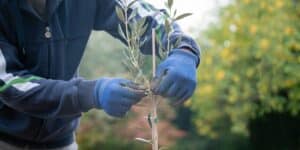By: Shelby McCullough| Published: October 17, 2022
If you are looking for expert tree maintenance or tips on how to care for newly planted trees, call McCullough Tree Service at (407) 734-5854.

After transplanting a tree into your yard, you need to know how to take care of it to help it acclimate while minimizing the shock that can cause stress in your new tree.
Follow these tips from the certified arborists at McCullough Tree Service, a tree service provider in Orlando, FL, to ensure your tree’s health all year long.
How to Care for Newly Planted Trees
These tips aim to give your newly planted tree a strong and healthy start at your home. Many gardeners who plant trees don’t know how to properly water, prune, or fertilize their saplings and transplants. Keep reading for six crucial steps to care for your newly planted tree.
1. Follow these Tree Watering Guidelines
The best tree watering method for newly transplanted root balls will require approximately 10 to 15 gallons of water each week. For larger trees, this amount becomes a calculation of eight to ten gallons per inch of trunk diameter per week. For example, a tree with a trunk diameter of four inches will need approximately 40 gallons of water each week.
- Water Placement: Avoid using a sprinkler system for your newly-planted trees. While watering the root ball area is important, you need to avoid getting water on the trunk. You can use a slow trickle hose, soaker hose, drip irrigation system, or a tree watering bag for the best results.
- Watering Frequency: You should give your tree water every two to three days. The texture and level of moisture in the soil surrounding your tree can provide hints about when your tree needs water. Simply dig into the soil with your hand to test the dryness.
Soil that quickly crumbles and blows away in the wind is too dry, indicating a need for fresh water. The moisture level is adequate if the soil is damp enough to hold a shape. If you pick up a handful of dirt and can squeeze water out of it, there is too much water, and you’ll need to wait a while to resume watering.
2. Mulch Your Trees
While not every gardener or arborist uses mulch, this optional addition to your newly planted tree has benefits you might not expect. A healthy layer of mulch can:
- Improve water retention for better soil moisture levels
- Regulate soil temperature
- Add organic nutrients
- Prevent damage from mowers and trimmers
- Reduce competition for water between surrounding plantlife
You can only enjoy these benefits if you apply mulch to the area correctly. Keep the following tips in mind when deciding to add mulch around your trees:
- Apply mulch four to six inches away from the trunk’s base to prevent rot and pest infestation.
- Extend the mulch outward to match the canopy spread of the tree.
- Layer the mulch to a depth of at least one inch but no more than four inches deep.
- Break apart matted patches of mulch to maintain its efficacy over time.
You can choose to use wood chips, pine straw, leaf mulch, or shredded bark to help protect and provide soil nutrients for your new tree.
3. Avoid Pruning Your Trees
When learning how to care for newly planted trees, you might think pruning is a good idea. However, for the first year following the transplant, you should avoid any pruning that isn’t absolutely necessary. Only remove dead or broken branches during this critical time.
After your new tree has acclimated to your yard, you can begin pruning to control the branch spacing and better balance the canopy spread as it grows.
4. Don’t Fertilize Yet
In addition to pruning, you might feel tempted to fertilize your newest plant to encourage it to grow into a healthy tree. Unlike flowers, trees don’t need an immediate infusion of fertilizer to boost their growth.
Trees need to wait at least one to four years after transplantation to fully establish a healthy root base that is strong enough to handle more growth. Once your tree establishes its root system, you can begin using a slow-release fertilizer in late winter or early spring.
5. Use a Staking Kit if Necessary
There are a few circumstances that may cause a new tree to require staking. Staking kits help provide additional stability and support or anchor new trees in the path of strong winds.
In the rare case that your new tree has to rely on a staking kit, you should only leave it in place for the first year or two at most. These devices are useful for short periods, but if left in place unattended, they can ultimately damage the health of your newly planted tree.
6. Monitor New Tree Health
A significant part of how to care for newly planted trees is to observe and monitor the plants for signs of pests or infection. You should also take some time to learn any special details about your new tree to ensure you take the best steps to take care of the tree.
Young saplings and some species of trees have a thinner bark that is more susceptible to sunscald, which can lead to insect infestation or fungal growth. These trees benefit from a seasonal wrapping process that protects the trunk from potential damage.
How to Care for Newly Planted Trees: Call the Tree Care Experts at McCullough Tree Service
Knowing how to care for newly planted trees will help you feel more confident in your decision to improve your yard. If you’re not sure what your tree needs or just want a professional to take care of the hard work for you, contact the certified arborists at McCullough Tree Service.
Are you ready to learn more about the art of growing healthy trees? Learn about low-maintenance trees that make for easier and still beautifying additions to your property.
Call McCullough Tree Service at (407) 734-5854 for a free quote to improve your curb appeal.

